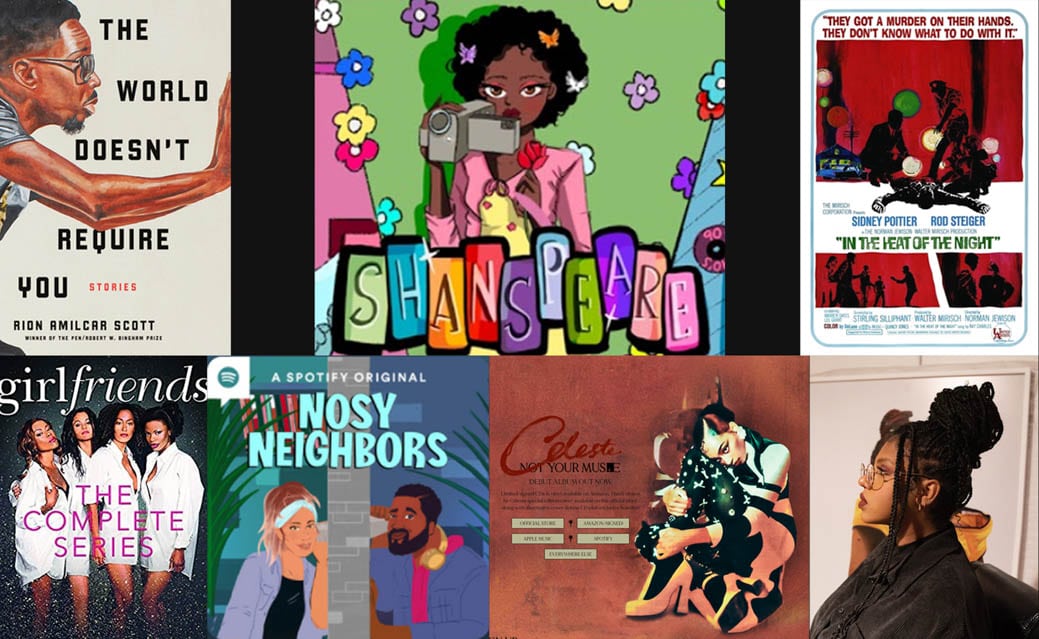A celebration of Black Voices in media
Featuring Black creators, find your next favourite in this collection that aims to educate and entertain.
Music—Celeste
Serena Uribe
Celeste is an American-British singer of English and Jamaican descent. In 2017, the soulful, jazzy blues and R&B soloist released her debut EP The Milk and Honey. Since then, Celeste has steadily released a slew of EPs, albums, and songs—including a feature in the soundtrack of Disney and Pixar’s Soul. She has also received several awards, including a 2020 BRIT Award for her song “Herself” in the “Rising Star” category, and multiple nominations.
It is Celeste’s sultry, lulling, and gritty rawness that hooks you. Her vocals are reminiscent of soul, jazz, ballads, and blues masters of the past intertwined with contemporary R&B and neo-soul. Celeste’s style renders homage to Aretha Franklin, Billie Holiday, Janis Joplin, and Erykah Badu, surely making them proud as she remains true to her own unique style. Celeste’s songs explore an array of topics and emotions: from new love to old love, break-ups to breakdowns, from hardships to healing, to loving yourself and feminine empowerment, and it does not stop there. For soothing melodies, harmonious instrumentals, and raw emotion, you can find Celeste’s music on all platforms.
Artist—Esmaa Mohamoud
Serena Uribe
Esmaa Mohamoud is a Toronto-based artist of African descent who was born and raised in London, Ontario. As a contemporary artist, her art spans various mediums like photography, installation, sculpture, performance art, and drawings. She navigates issues of race, gender, and class with a specific focus on the Black body. Mohamoud draws her artistic inspiration from the history of slavery to post-emancipation and the civil rights era, modern and contemporary issues of racial politics, and the politics of the Black body. In many of her works, she harkens back to her own upbringing.
Mohamoud is recognized for her talent and creativity, as well as the way she brings light to ongoing issues of racial disparities through her artistic outlets. One of her artworks, a large mural titled The Brotherhood FUBU (For Us, By Us), is currently on display at the Westin Harbour Castle Conference Centre in Toronto.
TV Show—Girlfriends
Serena Uribe
Girlfriends is a traditional sitcom television series that debuted on September 11, 2000. With a predominantly Black cast, the series follows the lives of four Los-Angeles-based girlfriends: Joan Carol Clayton (Tracee Ellis Ross), Maya Denise Wilkes (Golden Brooks), Lynn Ann Searcy (Persia White), and Antoinette “Toni” Marie Childs-Garett (Jill Marie Jones).
Each episode explores a different concern, such as marriage, divorce, breakups, new relationships, friendships, career-related issues, and money problems, as well as addresses more complex issues like race and gender. Through the ups and downs of life, girlfriends Joan, Maya, Lynn, and Toni have each other.
Film—In the Heat of the Night (1967)
Ahmed Azeemuddin
In the Heat of the Night is a 1967 film directed by Norman Jewison and is an adaptation of the eponymous 1965 novel by John Ball. The film stars Sidney Poitier as a Black Philadelphian homicide detective named Virgil Tibbs, who passes through the town of Sparta, Mississippi; Rod Steiger plays Sparta police chief Bill Gillespie, who is forced to work with Tibbs to solve a murder.
We see the first of several racist encounters that Tibbs faces as he silently allows the deputy (Warren Oates) to frisk him and haul him down to the police station. Poitier’s strong performance as the morally righteous Tibbs defies the stereotypes that Black characters would normally have in films.
Poitier is regarded as Hollywood’s first Black film star and is heralded as the “Martin Luther King Jr. of Hollywood” in the sense that he paved the way for other Black film stars. It was common during this era for Black characters to be written as stereotypes or in smaller parts that were easily cut from the film, but Poitier’s prominence in films opened the doors for more representative roles.
Virgil Tibbs is regarded as Poitier’s most famous role, and while the film can be uneven at times, it is worth it to see the man they called Mister Tibbs.
Podcast—Nosy Neighbors
Elizabeth Provost
Nosy Neighbors, a Spotify original hosted by comedians (and friends) Chinedu Unaka and Candice Thompson, offers the inside scoop of the craziest stories of Karen sightings, petty forum posts, neighbour rivalry—and on a positive note—community. The hosts’ charisma and charm, as well as their fine-tuned sense of humour, make Nosy Neighbours a hilarious (and sometimes disturbing) listen. Do your neighbours throw hot dogs into your backyard? Have you seen a loose lion strolling around your house?
Each episode also features a celebrity guest appearance who graces the audience with their own notable neighbour stories, including actors and comedians like Whitney Cummings, Tiffany Haddish, and Damon Wayans Jr. among others.
With these stories and tangents of their own experiences, Unaka and Thompson keep listeners entertained with a new episode every week.
Book—The World Doesn’t Require You
Whitney Buluma
Rion Amilcar Scott’s The World Doesn’t Require You celebrates Black subjectivity, using satire to deftly expose the distorted absurdities of racist and sexist stereotypes. This bizarre collection of 11 short stories and one novella is set in the fictional town of Cross River, a majority Black community established in Maryland after the only successful slave revolt in America.
Scott’s lyrical prose breathes life into Cross River. One story, “Rolling in My Six-Fo,” confronts blackface and minstrel shows with surrealism—satire nested within satire. The last novella, “Special Topics in Loneliness Studies,” is a sometimes earnest, sometimes acerbic exploration of a professor’s descent into madness. However, it is also a smart, multilayered analysis of the dangers of uncritical belief and didactic teaching practices.
At every turn, Scott leverages Cross River’s rich alternate history to reckon with the tyrannical lasting impact of slavery. His focus on showcasing a multiplicity of Black voices means that the characters’ inherent humanity shines through—and perhaps because of—the absurdity.
YouTube—Shanspeare
Sidra Durrani
While it may feel like the commentary space on YouTube is filled entirely by white men, YouTuber Shanspeare offers a refreshing perspective on the platform as a Black woman. Her videos give fascinating insights into various topics ranging from pop culture to academia. With her biting wit, clever sense of humor, and wardrobe that expertly matches the subject of her videos, she entertains hundreds of thousands of subscribers. Whether she dresses up as a playboy bunny to discuss the “girlboss-ification” of horror movies or dons a grey wig and beard to talk about mommy issues as Sigmund Freud, there is bound to be something on her channel for everyone.
Shanspeare often addresses aspects of culture that are not widely discussed, such as the unique challenges that Black women face, and it is vital for allies to listen to and help amplify BIPOC (Black, Indigenous, and People of Colour) voices. In an age where viewers are becoming more open to the idea of long-form video essays, Shanspeare’s videos are a great place to start if you are not familiar with the medium or if you are looking for a new channel to binge.



